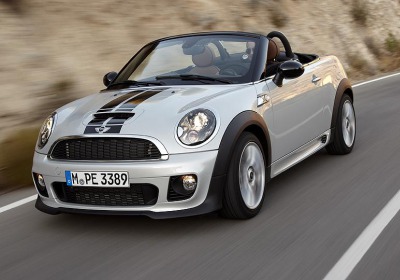2012 Mini roadster revealed
Sat, 29 Oct 2011
Mini has revealed the definitive production version of its 2012 roadster.
Sister car to the recently introduced coupe, alongside which it will be built at Mini's Oxford plant in England, the compact two-seater arrives a little more than two years after it was first shown in lightly veiled concept car guise at the 2009 Frankfurt motor show.
Rival to the enduring Mazda Miata, the Mini roadster is planned to make its public debut at the Detroit auto show in January prior to going on sale in North America in mid-2012. Pricing is yet to be announced, though officials suggest that the base Cooper model will start at about $24,000, some $2,000 more than its fixed-roofed sibling.
At 146.8 inches in length, 64.5 inches in width and 54.7 inches in height, the roadster is a scant 0.1 inch shorter, 1.9 inches narrower and 1.0 inch lower than Mini's existing open-top model, the second-generation cabriolet on sale in the United States since 2009. Unlike its four-seat open-top sibling, though, Mini's latest model is a strict two-seater, with the space behind the seats dedicated to extending luggage capacity, as in the coupe.
In line with Mini's original design brief for the roadster, the multilayered structure can be lowered from the driver's seat, folding back behind the seats in a space ahead of a rear liftback.
Nominal trunk space is put at 8.8 cubic feet, about 4.1 cubic feet more than that quoted for its open-top sibling, owing to the lack of rear seats. A 14.2-inch wide and 7.9-inch high aperture within the rear bulkhead can be accessed from the driver and passenger seat, providing added load through versatility for skis and other lengthy items.
Mirroring the move taken with its new coupe, the roadster will be sold with Mini's familiar 1.6-liter four-cylinder direct-injection gasoline engine in three different states of tune. In naturally aspirated guise it kicks out 121 hp in the Cooper, while twin-scroll turbocharged versions produce 181 hp in the Cooper S and 208 hp in the range-topping John Cooper Works models.
Also available in Europe but not planned for sale in North America will be a 2.0-liter four-cylinder common-rail diesel engine with 141 hp in the Cooper SD. It is claimed to provide 0-to-62-mph acceleration in 8.1 seconds, a 131-mph top speed and combined fuel consumption of 52.2 mpg in manual form on the European test cycle.
As with the coupe, with which it not only shares its exterior and interior designs but also its complete mechanical package, the roadster will be available exclusively with front-wheel drive. Gearbox choices include a standard six-speed manual on all models. An optional six-speed automatic is also available on all models save for the John Cooper Works.
Mini is talking up the dynamic properties of the roadster, suggesting that its lightweight fabric hood gives it a lower center of gravity than other models. The steel body structure adopts the same stiffening measures as the coupe, including a substantial brace at the rear that is said to boost overall rigidity to a level comparable to that of the hardtop. With a weight distribution biased toward the front, officials also claim the new open-top has better traction than earlier Mini models.
The roadster is the sixth model to join the modern day Mini lineup, after the hardtop, cabriolet, the Clubman, the Countryman and the coupe.
A seventh Mini model--in the form of a production version of the three-door Paceman concept car first revealed at the Detroit auto show in January 2011 and currently undergoing the final phase of development at parent company BMW's R&D center in Munich, Germany--is planned to be introduced in 2012. Based on the Countryman, it will offer the choice of either front- or four-wheel drive and will be produced at Magna in Graz,
By Greg Kable

